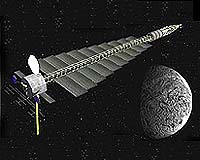
|
|
PREVIOUS ISSUE
MARSDAILY SPACEMART SPACEWAR SPACE TRAVEL TERRADAILY ASTRONAUTIX EMAIL US /ABOUT US SPACEDAILY FORUMS Paid Links |
 NASA Plans Nuclear Electric Mission To Jupiter
NASA Plans Nuclear Electric Mission To JupiterWashington (UPI) March 29, 2004  By Frank Sietzen
By Frank SietzenNASA's new strategy for sending humans back to the moon or onward to Mars includes employing a race of advanced robots - some of which will be tested within five years - on interplanetary jaunts to the farthest locations in the solar system. The new robotic probes will be fueled by a new generation of rockets powered by a new class of atomic powerplants that will give the spacecraft unprecedented capabilities, agency officials told United Press International. |
|
Boeing Snags $189 Million Pentagon Space Radar Contract St. Louis (AFP) Mar 31, 2004
St. Louis (AFP) Mar 31, 2004The Boeing Company said Tuesday that it has snagged a 189 million dollar contract to develop and operate a space-based surveillance system for the US Air Force. The contract calls for Boeing and its partner Ball Aerospace and Technologies Corp. to develop and launch a satellite capable of tracking the movement of objects through space by late 2007. U.S. Takes First Step To Weaponize Space  Washington (UPI) Mar 30, 2004
Washington (UPI) Mar 30, 2004Washington's Missile Defense Agency has earmarked $68 million for what some believe is the first step for putting weapons in space, ABC News reported Tuesday. Known as the Near Field Infrared Experiment or NFIRE satellite, it is primarily designed to gather data on exhaust plumes from rockets launched from earth. |
Planetary Scientists Call For Exploration Tucson - Mar 31, 2004
Tucson - Mar 31, 2004Two University of Arizona planetary scientists will testify this week before the House Subcommittee on Space and Aeronautics. The subcommittee is studying the feasibility of lunar-based scientific and commercial activities. Surrey's DMC Satellites Reach Targeted Orbit Station  Guilford UK - Mar 31, 2004
Guilford UK - Mar 31, 2004All four satellites for Surrey'sin internationalthe international Disaster Monitoring Constellation, co-ordinated by SSTL, have reached their designated targeted orbit stations in preparation for full operation of the this unique constellation of EO microsats. |
New Engine For Next-Generation Space Launch Vehicles Redondo Beach CA - Mar 31, 2004
Redondo Beach CA - Mar 31, 2004Northrop Grumman has developed and successfully tested a Reaction Control Subsystem (RCS) engine for next-generation reusable space launch and transportation vehicles. The new engine burns nontoxic propellants, an achievement that enhances safety, reliability and affordability. NASA Engineer Serves As Inspiration  Moffett Field - Mar 31, 2004
Moffett Field - Mar 31, 2004She may not look like a typical NASA engineer, but behind the soft smile and calm voice is an educated, intelligent woman with power and influence. "In looking back, I don't see that there was one great decision that led me to who I am today. There were many smaller decisions," recalls Dr. Tina Panontin. New Nanosensors A Body Can Live With  Tucson - Mar 31, 2004
Tucson - Mar 31, 2004For two decades, chemists have been making great strides in analyzing the biological functions that drive living cells. But many biological substances still remain undetectable. |
Methane on Mars Moffett Field - Mar 31, 2004
Moffett Field - Mar 31, 2004Considered suggestive of life, an atmosphere of methane on another planet is considered one of the four best candidates for detecting habitable conditions using remote sensing and telescope spectrographs. Mars Express Confirms Methane In The Martian Atmosphere  Paris - Mar 31, 2004
Paris - Mar 31, 2004Observations from the ESA Mars Express spacecraft in orbit around Mars, methane have detected in its atmosphere. Whilst it is too early to draw any conclusions on its origin, exciting as they may be, scientists are thinking about the next steps to take in order to understand more. NASA To Test Computer 'Mobile Agents' And Helper Robots  Moffett Field - Mar 31, 2004
Moffett Field - Mar 31, 2004NASA is testing intelligent 'mobile agent' software this week that some day may help astronaut-robot teams on Mars to communicate with Earth. |
| The contents herein, unless otherwise known to be public domain, are Copyright 1995-2004 - SpaceDaily. AFP Wire Stories are copyright Agence France-Presse ESA Portal Reports are copyright European Space Agency. Additional copyrights may apply in whole or part to other bona fide parties. Advertising does not imply endorsement, agreement or approval of any opinions, statements or information provided by SpaceDaily on any web page published or hosted by SpaceDaily. Privacy Statement |